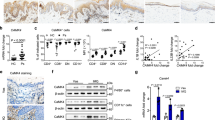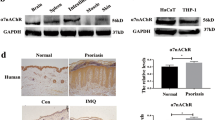Summary
Various studies have suggested that calmodulin (CaM) is involved in the pathophysiology of psoriasis. Protein kinase C (PKC) is also accepted as playing a regulatory role in cell proliferation as well as in inflammatory processes. Therefore, we investigated the effects of the known CaM antagonist tiflucarbine (BAY/TVX P 4495) on two cellular systems related to the major clinical symptoms of psoriasis: proliferation of cultured human keratinocytes (HaCaT cell line) and release of reactive oxygen species (ROS) from human polymorphonuclear leukocytes (PMNL). Tiflucarbine inhibited both cellular responses in a dose dependent manner. Furthermore, tiflucarbine directly affected PKC, and may thus be considered to be a dual PKC/CaM antagonist with putative antipsoriatic activity. The effects of tiflucarbine on the different parameters were compared with those of the structurally unrelated dual PKC/CaM inhibitor W-7 and those of the potent PKC inhibitor staurosporine. The potencies of all three compounds were found to be in the same range as their PKC-inhibiting potency. Our data indicate that PKC, rather than CaM, may play a regulatory role in the release of ROS as well as in keratinocyte proliferation. Therefore, inhibition of PKC in general might have a therapeutic benefit in psoriasis.
Similar content being viewed by others
Abbreviations
- CaM:
-
calmodulin
- CL:
-
chemiluminescence
- DMSO:
-
dimethyl sulfoxide
- EDTA:
-
ethylene diamine tetraacetic acid
- EGTA:
-
ethylene glycol-bis (Β-aminoethylether) tetraacetic acid
- PBS:
-
Dulbecco's buffered phosphate saline
- PKC:
-
protein kinase C
- PMA:
-
phorbol-12-myristate-13-acetate
- PMNL:
-
polymorphonuclear leukocytes
- PS:
-
phosphatidylserine
- ROS:
-
reactive oxygen species
- W-7:
-
N-(6-aminohexyl)-5-chloro-1-naphthalene sulfonamide
References
Bonnekoh B, Wevers A, Jugert F, Merk H, Mahrle G (1989) Colorimetric growth assay for epidermal cell cultures by their crystal violet binding capacity. Arch Dermatol Res 281:487–490
Bonnekoh B, Farkas B, Geisel J, Mahrle G (1990) Lactate dehydrogenase release as an indicator of dithranol-induced membrane injury in cultured human keratinocytes. Arch Dermatol Res 282:325–329
Boukamp P, Petrussevska RT, Breitkreutz D, Hornung J, Markham A, Fusenig NE (1988) Normal keratinization in a spontaneously immortalized aneuploid human keratinocyte cell line. J Cell Biol 106:761–771
Bradford M (1976) A rapid and sensitive method for the quantitation of microgram quantities of protein using the principle of protein-dye binding. Anal Biochem 72:248–254
Christiansen NO, Larsen CS, Esmann V (1988) A study of the role of protein kinase C and intracellular calcium in the activation of superoxide generation. Biochim Biophys Acta 971:317–324
Eichelberg D, Fuchs A (1988) Calmodulin-antagonism inhibits human keratinocyte proliferation. Arch Dermatol Res 280:323–324
Fisher GJ, Harris VA, Voorhees JJ (1987) Purification and characterization of calcium/phospholipid-dependent kinase from adult human epidermis. J Invest Dermatol 89:484–488
Fisher GJ, Talwar HS, Tavakkol A, Esmann J, Baldassare JJ, Elder JT, Griffith CEM, Baadsgaard O, Cooper KD, Voorhees JJ (1990) Phosphoinositide-mediated signal transduction in normal and psoriatic epidermis. J Invest Dermatol 95:15–17
King LE, Gates RE, Stoscheck CM, Nanney LB (1990) Epidermal growth factor/transforming growth factor α-receptors and psoriasis. J Invest Dermatol 95:10–12
Glaser T, Seidel PR (1987) Tiflucarbine. Drugs Future 12:562–564
Hegemann L, Bonnekoh B, Fruchtmann R, Müller-Peddinghaus R, van Rooijen LAA, Mahrle G (1990) Evidence that the antipsoriatic drug anthralin acts by inhibition of protein kinase C. Skin Pharmacol 3:196
Hegemann L, Bonnekoh B, Schmidt BH, van Rooijen LAA, Mahrle G (1990) Mechanism of drug induced inhibition of keratinocyte proliferation: inhibition of protein kinase C or antagonism of calmodulin? Biol Chem Hoppe Seyler 371:740–741
Ma W, Laskin JD (1990) Inhibition of protein kinase C activity by photoactivated psoralens. J Invest Dermatol 94:552
Marcelo CL, Voorhees JJ (1983) Cyclic nucleotides, prostaglandins and polyamines in psoriasis. In: Baden HP (ed) The chemotherapy of psoriasis. Pergamon Press, New York Oxford Toronto, pp 111–124
Müller-Peddinghaus R, Wurl M (1987) The amplified chemiluminescence test to characterize antirheumatic drugs as oxygen radical scavengers. Biochem Pharmacol 36:1125–1132
Nishizuka Y (1984) The role of protein kinase C in cell surface signal transduction and tumour promotion. Nature 308:693–697
Nishizuka Y (1989) The family of protein kinase C for signal transduction. JAMA 262:1826–1833
O'Brian CA, Ward NE (1989) Binding of protein kinase C to N-(6-aminohexyl-5-chloro-1-naphthalenesulfonamide through its ATP binding site. Biochem Pharmacol 38:1737–1742
Ochs DL, Reed PW (1981) Inhibition of the neutrophil oxidative burst and degranulation by phenothiazines. Biochem Biophys Res Commun 102:958–962
Ohtuska T, Okamura N, Ishibashi S (1986) Involvement of protein kinase C in the phosphorylation of 46 kDa proteins which are phosphorylated in parallel with activation of NADPH oxidase in intact guinea-pig polymorphonuclear leukocytes. Biochim Biophys Acta 888:332–337
Rüegg UT, Burgess GM (1989) Staurosporine, K-252 and UCN-01: potent but nonspecific inhibitors of protein kinases. Trends Pharmacol Sci 10:218–220
Schmidt BH, Schultz JE (1986) The potential antidepressant tiflucarbine downregulates Β-adrenoreceptors in rat brain. Eur J Pharmacol 130:27–35
Schmidt BH, Glaser T, Traber J (1990) Characteristics of tiflucarbine binding to calmodulin. Eur J Pharmacol 189:411–418
Snoek GT, Boonstra J, Ponec M, de Laat SW (1987) Phorbol ester binding and protein kinase C activity in normal and transformed keratinocytes. Exp Cell Res 172:146–157
Tamaoki T, Nomoto H, Takahashi I, Kato Y, Morimoto M, Tomita F (1986) Staurosporine, a potent inhibitor of phospholipid/Ca++-dependent protein kinase. Biochem Biophys Res Commun 135:397–402
Tanaka T, Ohmura T, Yamakado T, Hidaka H (1982) Two types of calcium-dependent protein phosphorylation modulated by calmodulin antagonists. Mol Pharmacol 22:408–412
Tomlinson T, MacNeil S, Walker SW, Ollis CA, Merritt JE, Brown BL (1984) Calmodulin and cell function. Clin Sci 66:497–508
Tucker WFG, MacNeil S, Dawson RA, Tomlinson S, Bleheen SS (1986) Calmodulin levels in psoriasis: the effect of treatment. Acta Derm Venereol (Stockh) 66:241–244
van de Kerkhoff PCM, van Erp PEJ (1983) Calmodulin levels are grossly elevated in the psoriatic lesion. Br J Dermatol 108:217–218
Walker RJ, Lazzaro VA, Duggin GG, Horvath JS, Tiller DJ (1989) Cyclosporine A inhibits protein kinase C: a contributing mechanism in the development of nephrotoxicity. Biochem Biophys Res Commun 160:409–415
Wollina U, Klinger R, Wetzker R, Reissmann R, Knopf B (1989) Immunohistochemical localization of calmodulin in normal and psoriatic epidermis. Arch Dermatol Res 280:497–498
Wright CD, Hoffman MD (1987) Comparison of the roles of calmodulin and PKC in activation of the human neutrophil respiratory burst. Biochem Biophys Res Commun 142:53–62
Wymann MP, von Tscharner V, Deranleau DA, Baggiolini M (1987) The onset of the respiratory burst in human neutrophils. J Biol Chem 262:12048–12053
Author information
Authors and Affiliations
Rights and permissions
About this article
Cite this article
Hegemann, L., Fruchtmann, R., Bonnekoh, B. et al. Effects of tiflucarbine as a dual protein kinase C/calmodulin antagonist on proliferation of human keratinocytes and release of reactive oxygen species from human leukocytes. Arch Dermatol Res 283, 456–460 (1991). https://doi.org/10.1007/BF00371782
Received:
Issue Date:
DOI: https://doi.org/10.1007/BF00371782




